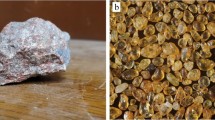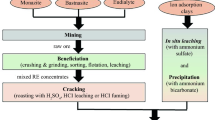Abstract
Voluminous stockpiles of phosphogypsum (PG) generated during the wet process production of phosphoric acid are stored at many sites around the world and pose problems for their safe storage, disposal, or utilization. A major concern is the elevated concentration of long-lived 226Ra (half-life = 1,600 years) inherited from the processed phosphate rock. Knowledge of the abundance and mode-of-occurrence of radium (Ra) in PG is critical for accurate prediction of Ra leachability and radon (Rn) emanation, and for prediction of radiation-exposure pathways to workers and to the public. The mean (±SD) of 226Ra concentrations in ten samples of Jordan PG is 601 ± 98 Bq/kg, which falls near the midrange of values reported for PG samples collected worldwide. Jordan PG generally shows no analytically significant enrichment (<10%) of 226Ra in the finer (<53 μm) grain size fraction. Phosphogypsum samples collected from two industrial sites with different sources of phosphate rock feedstock show consistent differences in concentration of 226Ra and rare earth elements, and also consistent trends of enrichment in these elements with increasing age of PG. Water-insoluble residues from Jordan PG constitute <10% of PG mass but contain 30–65% of the 226Ra. 226Ra correlates closely with Ba in the water-insoluble residues. Uniformly tiny (<10 μm) grains of barite (barium sulfate) observed with scanning electron microscopy have crystal morphologies that indicate their formation during the wet process. Barite is a well-documented and efficient scavenger of Ra from solution and is also very insoluble in water and mineral acids. Radium-bearing barite in PG influences the environmental mobility of radium and the radiation-exposure pathways near PG stockpiles.






Similar content being viewed by others
References
Abed, A. M. (1994). Shallow marine phosphorite-chert-palygorskite association, Upper Cretaceous Amman Formation, Jordan. In A. Iijima, A. M. Abed, & R. Garrison (Eds.), Siliceous, phosphatic and glauconitic sediments in the Tertiary and Mesozoic. Proceedings of the 29th international geology congress, part C (pp. 205–224). The Netherlands: VSP.
Abed, A. M., & Abu-Murry, O. S. (1997). Rare earth element geochemistry of the Jordanian Upper Cretaceous Phosphorites. The Arab Gulf Journal Science Research, 15(1), 41–61.
Abed, A. M., Rushdi, S., & Mustafa, A. (2008). Uranium and potentially toxic metals during the mining, beneficiation, and processing of phosphorite and their effects on ground water in Jordan. Mine Water Environment. doi:10.1007/s10230-008-0039-3.
Abed, A. M., & Sadaqah, R. (1998). Role of Upper Cretaceous oyster buildups in the deposition and accumulation of high-grade phosphorites in central Jordan. Journal of Sediment Research, 68(5), 1009–1020.
Abed, A. M., Sadaqah, R., & Al-Jazi, M. (2007). Sequence stratigraphy and evolution of Eshidiya phosphorite platform, southern Jordan. Journal of African Earth Sciences, 27, 39–54.
Abril, J. M., Garcia-Tenorio, R., Perianez, R., Enamorado, S. M., Andreu, L., & Delgado, A. (2009). Occupational dosimetric assessment (inhalation pathway) from the application of phosphogypsum in agriculture in southwest Spain. Journal of Environmental Radioactivity, 100, 29–34.
Adrianov, A. M., Rusin, N. F., Burtnenko, L. M., & Fedorenko, V. D. (1976). Influence of the main process parameters on the effectiveness of leaching of rare earth elements (RE) from phosphogypsum by sulfuric acid. Journal of Applied Chemistry, USSR, 49, 656–658.
Al-Jundi, J., Al-Ahmad, N., Shehadeh, H., Afaneh, F., Maghrabi, M., & Gerstmann, U. (2008). Investigations on the activity concentrations of 238U, 226Ra, 228Ra, 210Pb, and 40K in Jordan phosphogypsum and fertilizers. Radiation Protection Dosimetry, 131(4), 449–454.
Al-Masri, M. S., Ali, A. I., Khietou, M., & Al-Hares, Z. (1999). Leaching of Ra-226 from Syrian phosphogypsum. In G. W. A. Newton (Ed.), Environmental radiochemical analysis (pp. 21–29). London: Royal Society of Chemistry.
Berdanosova, D. G., Burlakova, E. V., Yasenkova, M. A., Ivanov, L. N., & Melikhov, I. V. (1989). Characteristics of transfer of europium ions from phosphoric acid solutions into the CaSO4 · 0.5H2O solid phase. Journal of Applied Chemistry USSR, 62, 211–216.
Beretka, J., & Mathew, P. J. (1985). Natural radioactivity of Australian building materials, industrial wastes and by-products. Health Physics, 48, 87–95.
Berish, C. W. (1990). Potential environmental hazards of phosphogypsum storage in central Florida. Proceedings of the third international symposium on phosphogypsum, Orlando, Florida, Florida Institute of Phosphate Research FIPR pub. no. 01-060-083, Vol. 2, pp. 1–29.
Bolivar, J. P., Garcia-Tenorio, R., & Garcia-Leon, M. (1996). On the fractionation of natural radioactivity in the production of phosphoric acid by the wet method. Journal of Radioanalytical and Nuclear Chemistry Letters, 214(2), 77–88.
Budahn, J. R., & Wandless, G. A. (2002). Instrumental neutron activation analysis by long count. In J. E. Taggert (Ed.), Analytical methods for chemical analysis of geologic and other materials, US Geological Survey. US Geological Survey open-file report 02-223, Chap. X, pp. X1–X13.
Burnett, W. C., Chin, P., Deetae, S., & Panik, P. (1988). Release of radium and other decay-series isotopes from Florida phosphate rock. Final report, Florida Institute of Phosphate Research FIPR pub. 05-016-059.
Burnett, W. C., Cowart, J. B., LaRock, P., & Hull, C. D. (1995). Microbiology and radiochemistry of phosphogypsum. Final report, Florida Institute of Phosphate Research FIPR pub. 05-035-115.
Burnett, W. C., & Elzerman, A. W. (2001). Nuclide migration and the environmental radiochemistry of Florida phosphogypsum. Journal of Environmental Radioactivity, 54, 27–51.
Burnett, W. C., Schaefer, G., & Schultz, M. K. (1999). Fractionation of Ra-226 in Florida phosphogypsum. In G. W. A. Newton (Ed.), Environmental radiochemical analysis (pp. 1–20). London: Royal Society of Chemistry.
Capetta, H., Pfeil, F., Schmidt-Kittler, N., & Martini, E. (1996). New biostratigraphic data on the marine Upper Cretaceous and Paleogene of Jordan. Jordan Phosphate Mining Company, Amman Jordan, Internal report.
Doerner, H. A., & Hoskins, W. M. (1925). Co-precipitation of radium and barium sulfates. Journal of the American Chemical Society, 47, 662–675.
European Directive. (1996). Directive 96/29/Euratom-ionizing radiation. http://osha.europa.eu/en/legislation/directives/exposure-to-physical-hazards/osh-directives/73.
Federal Register. (1990, 10 April). Vol. 55, No. 69, pp. 13480–13481.
Federal Register. (1991, 21 May). Vol. 56, p. 23398. http://www.nrc.gov/reading-rm/doc-collections/cfr/part020/part020-1301.html.
Federal Register. (1992, 3 June). Vol. 57, No. 107, pp. 23305–23320.
Fedorak, P. M., Westlake, D. W. S., Anders, C., Kratochvil, B., Motosky, N., Anderson, W. B., & Huck, P. M. (1986). Microbial release of 226Ra+2 from (Ba,Ra)SO4 sludges from uranium mine wastes. Appl. Environ. Microbiol. 52, 262–268.
Grauch, R. I., Desborough, G. A., Meeker, G. P., Foster, A. L., Tysdal, R. G., & Herring, J. R. (2004). Petrogenesis and mineralogic residence in the Meade Peak Phosphatic Shale Member of the Permian Phosphoria Formation, southeast Idaho. In J. R. Hein, et al. (Eds.), Life cycle of the Phosphoria formation: from deposition to the post-mining environment. Handbook of exploration and environmental geochemistry (Vol. 8, pp. 189–226). Amsterdam: Elsevier.
Hull, C. D., & Burnett, W. C. (1996). Radiochemistry of Florida phosphogypsum. Journal of Environmental Radioactivity, 32, 213–238.
Kim, K. P., Wu, C. Y., Birky, B. K., & Bolch, W. E. (2007). TENORM aerosols in the Florida phosphate industry-assessment of lung fluid solubility and annual effective dose to workers. Radiation Protection Dosimetry, 123(1), 41–55.
Luther, S. M., Dudas, M. J., & Rutherford, P. M. (1993). Radioactivity and chemical characteristics of Alberta phosphogypsum. Water, Air, Soil Pollution, 69, 277–290.
Masri, A. (1992). The geology of the Ath-Thulaythuat area. Map sheet no. 3249 III. Bull. no. 23, Natural Resources Authority, Jordan.
May, A., & Sweeney, J. W. (1984). Evaluation of radium and toxic element leaching characteristics of Florida phosphogypsum. In R. A. Kuntz (Ed.), The chemistry and technology of gypsum (pp. 140–159). Washington, DC: American Society of Testing Materials ASTM Spec. Tech. pub. no. 861.
Mazzilli, B., Palmiro, V., Saueia, C., & Nisti, M. B. (2000). Radiochemical characterization of Brazilian phosphogypsum. Journal of Environmental Radioactivity, 49, 113–122.
Michel, J. (1987). Radon transport mechanisms. In C. R. Cothern & J. E. Smith Jr. (Eds.), Environmental radon (pp. 86–92). New York: Plenum.
Moisset, J. (1980). Radium removal from phosphogypsum. Proceedings of the international symposium on phosphogypsum, Lake Buena Vista, Florida, Florida Institute of Phosphate Research FIPR pub. no. 01-001-017, pp. 383–397.
Moisset, J. (1988). Location of radium in phosphogypsum and improved process for removal of radium from phosphogypsum. Proceedings of the second international symposium on phosphogypsum, Miami, Florida, Florida Institute of Phosphate Research FIPR pub. no. 01-037-055, Vol. 1, pp. 303–317.
Moisset, J. (1990). Complete removal of radium from phosphogypsum. Proceedings of the third international symposium on phosphogypsum, Orlando, Florida, Florida Institute of Phosphate Research FIPR pub. no. 01-060-083, Vol. 1, pp. 181–196.
Piper, D. Z. (1974). Rare earth elements in the sedimentary cycle: a summary. Chemical Geology, 14, 285–304.
Quennell, A. M. (1951). The geology and mineral resources of Transjordan. Colonial Geology and Mineral Resources, 2, 85–115.
Rashdan, M. (1988). The regional geology of the Aqaba-Wadi Arab area. Map sheets 3049 II. Geological Mapping Division, Natural Resources Authority.
Roessler, C. E., Smith, C. A., & Bolch, W. E. (1979b). Management of low-level natural radioactivity wastes of phosphate mining and processing. Proceedings of the twelfth midyear topical symposium of the health physics society, Williamsburg, Virginia, pp. 182–195.
Roessler, C. E., Smith, Z. A., Bolch, W. E., & Prince, R. J. (1979a). Uranium and radium-226 in Florida phosphate materials. Health Physics, 37, 269–277.
Rood, A. S., White, G. J., & Kendrick, T. (1998). Measurement of 222Rn flux, 222Rn emanation, and 226,228Ra concentration from injection well pipe scale. Health Physics, 75(2), 187–192.
Rutherford, P. M., Dudas, M. J., & Arocena, J. M. (1995). Radon emanation coefficients for phosphogypsum. Health Physics, 69(4), 513–520.
Rutherford, P. M., Dudas, M. J., & Arocena, J. M. (1996). Heterogeneous distribution of radionuclides, barium, and strontium in phosphogypsum by-product. The Science of Total Environment, 180, 201–209.
Rutherford, P. M., Dudas, M. J., & Samek, R. A. (1994). Environmental impacts of phosphogypsum. The Science of the Total Environment, 149, 1–38.
Sadaqah, R. M., Abed, A. M., Grimm, K. A., & Pufahl, P. K. (2005). The geochemistry of rare earth elements (REE), yttrium (Y) and scandium (Sc) in some upper Cretaceous Jordanian phosphorites. Dirasat Pure Sciences, 32(1), 32–47.
Santos, A. J. G., Mazzilli, B. P., Favaro, D. I. T., & Silva, P. S. C. (2006). Partitioning of radionuclides and trace elements in phosphogypsum and its source materials based on sequential extraction methods. Journal of Environmental Radioactivity, 87, 52–61.
Smith, R. M., & Martell, A. E. (1976). Critical stability constants volume 4: Inorganic complexes. New York: Plenum.
Sofremines. (1984). Ore reserve evaluation. Report no. II. Jordan Phosphate Mines Company, Amman, Jordan, 149 pp.
US Geological Survey. (2008). Mineral commodity summaries: Phosphate rock. http://minerals.usgs.gov/minerals/pubs/commodity/phosphate_rocks/mcs-2008-phosp.pdf.
Zhu, C. (2004). Coprecipitation in the barite isostructural family: binary mixing properties. Geochimica et Cosmochimica Acta, 68(16), 3327–3337.
Zielinski, R. A., & Budahn, J. R. (1998). Radionuclides in fly ash and bottom ash; improved characterization based on radiography and low-energy gamma-ray spectrometry. Fuel, 77(4), 259–267.
Acknowledgments
This research was conducted over 9 months in 2004–2005 while the second author, M.S. Al-Hwaiti, was a visiting Fulbright Scholar at the Colorado School of Mines, Golden, Colorado. We thank the personnel of the Aqaba Industrial Complex and the Indo-Jordan Chemical Company for site access and for support of field sampling. R. L. Driscoll of the US Geological Survey (USGS) performed X-ray diffraction analysis and fine-particle separations. H.A. Lowers of the USGS provided assistance with the operation of the scanning electron microscope. Any use of trade, product, or firm names is for descriptive purposes only and does not imply endorsement by the US government.
Author information
Authors and Affiliations
Corresponding author
Rights and permissions
About this article
Cite this article
Zielinski, R.A., Al-Hwaiti, M.S., Budahn, J.R. et al. Radionuclides, trace elements, and radium residence in phosphogypsum of Jordan. Environ Geochem Health 33, 149–165 (2011). https://doi.org/10.1007/s10653-010-9328-4
Received:
Accepted:
Published:
Issue Date:
DOI: https://doi.org/10.1007/s10653-010-9328-4




